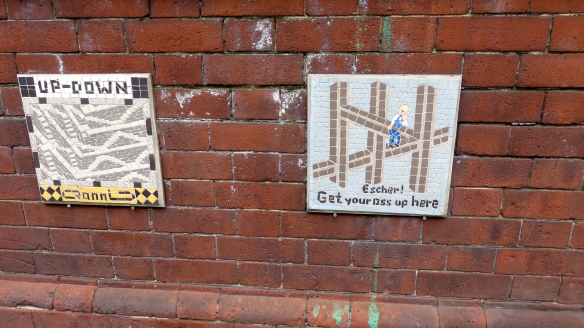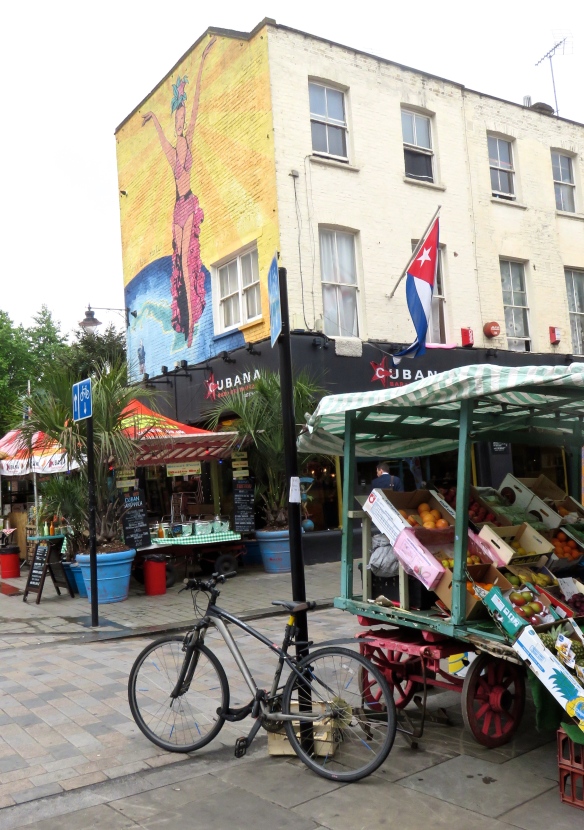Jackie, now recovered, drove me to and from New Milton,so that I could travel by train to Waterloo and back, for lunch with Norman.
Many people seemed to prefer lobbing their rubbish over the railway bridge or the chain link fence onto the embankment, to using the bin provided. Those responsible for the planters on the station platforms, however, clearly take pride in their appearance.
Isla, aged ten months, has been walking for a month. Not all the time. Able to stand on her mother’s lap, with ‘one shoe off, and one shoe on’, she took pleasure in repeatedly chucking one at my feet all they way from New Milton to Winchester. Her delight gave her the opportunity to display her two front teeth every time I picked up the missile. I couldn’t resist telling the child’s mother the story of Becky’s milestones.
Having arrived at Waterloo, I was to meet Norman at Tas Turkish restaurant in The Cut, a short walk from the station. 
On a wall on the taxis’ Approach Road opposite the station, a few mosaic panels have been fixed. I rather like the Escher one.  A set of steps brings you down to Lower Marsh. From there, passing La Cubana restaurant with its enticing mural, I continued to the Cut, on the corner of which stands The Old Vic, and proceeded to my rendezvous with my friend.
A set of steps brings you down to Lower Marsh. From there, passing La Cubana restaurant with its enticing mural, I continued to the Cut, on the corner of which stands The Old Vic, and proceeded to my rendezvous with my friend.
We began with falafel and garlic sausage starters. Our main course was the Tas special, a tender lamb dish. The house red wine was very quaffable, as was the coffee to follow. The prices were reasonable and the service good.
Jackie had not been idle whilst I was thus engaged. She bought two obelisks for roses and four more plants. At Redcliffe Nurseries she at last identified the lost label rose shown yesterday. It is the hybrid tea, Rose Gaujard.
On the train, and back at home, I finished reading Truman Capote’s ‘In Cold Blood’. I believe the term faction would adequately describe this work, based on the apparently random murder of a family of four in 1959. Capote thoroughly researched the event, the period leading up to it, and the eventual trial and execution of the perpetrators. That I take as fact. Obviously the victims could not be interviewed, but a number of the main characters were, not necessarily by Capote himself. It is therefore difficult to be sure what fiction the author has woven into his narrative.
The writing is clear, flowing, insightful, and descriptive. We can believe that Capote’s imaginative sections are true to the characters he is dissecting. Even on publication of this best-seller, readers knew who had committed the murder, and what was their fate. Capote’s skill has been, by moving backwards and forwards in time and place, to give us a gripping and credible detective story, not marred by the fact that the horrific events actually happened.
Whether or not it was the writer’s intention to point up the effects of childhood and mental ill-health on psychopathic behaviour, he certainly makes a case for them.
After more than half a century we still read of apparently random gun killings. Has anything been learned?
My Folio Society edition is illustrated by contemporary and earlier photographs, one of which adorns the front cover board.





I read that book many years ago and it left me chilled to the bone – you point out the connection he made between childhood experiences and subsequent psychological illness, as have many others before and since – We are both left wondering why ‘the experts’ have not connected the dots ………….. On a cheerier note, glad to see the rose mystery has been solved!
Thank you Pauline
I like the mural. It seems to be a very lively part of town. Thank you for reminding us about that great book 🙂
Thank you Sylvie
No, we never learn or history wouldn’t ‘repeat itself’. I like the mystery and romance of a lost label rose so am sad that its identity has been discovered. Had it been mine, however, I would have put on my detective hat. 🙂 I miss London, more so because I doubt if I’ll ever be back. I love street art.
Thank you Mary, If you ever come you’d better visit us.
The nameless rose is a hybrid tea, Rose Goujard. Oops! I’m too late!
🙂
One of the things I miss about so many parts of the UK is the civic pride; the window boxes, hanging planters, railway stations that actually have gardens. All of that was has long gone from Australia in the name of cost-cutting.
I imagine that it’s a bitter-sweet moment now to know what the un-named rose is called 🙂
Thank you Matt. You are right about the rose. Unlike for Mr Capote, the mystery solved is the end of the story. Still, we can enjoy Rose Gaujard
Ah, a trip on the train for lunch in London… Nostalgia hits… But briefly! One has to keep it in check, live in, and enjoy the present, not so? But I do so enjoy our trips with you Derrick! Thanks for sharing! 🙂
Many thanks Rob. Yes, we must live in and enjoy the present, but our past informs it. I’m pleased that you enjoy my ramblings
There’s a whole genre of writing called creative nonfiction and I wonder whether Capote didn’t lead the way. I have never really warmed to it myself. Are the imaginative bits due to sloppy research or lack of data? And where exactly are they? It’s the historian and data maven coming out in me. But mostly I read fiction, unless it’s news (and we don’t even want to start that discussion in this space). The gardener in me is pleased you found your rose’s name. And thanks for the Escher tile! That gave me a chuckle.
Thank you Lisa. Capote certainly thought he had created something new. I suspect the imaginative bits are those describing the perpetrators’ drive across America, and the padding out of the characters. I appreciate your varied comments resulting from close reading.
Serendipitously, given the current fuss about her, Harper Lee was Truman Capote’s fellow researcher on In Cold Blood.although he played down the extent of her involvement.
Thank you Theo
Liked the murals and the photos, also liked In Cold Blood, though I haven’t read it for years and am probably softer ion character by now. Sadly the only difference I can see in the world is that people have more effective guns..
You are right
I will add this to my ever-growing list of books to read.
Thanks, Ashley
Nice review ! 🙂 btw we recently made a book review In COLD BLOOD and it means the world if you can check it out and comment or give a follow ! ? we follow back. 🙂 http://bookidote.wordpress.com
Done, Trang